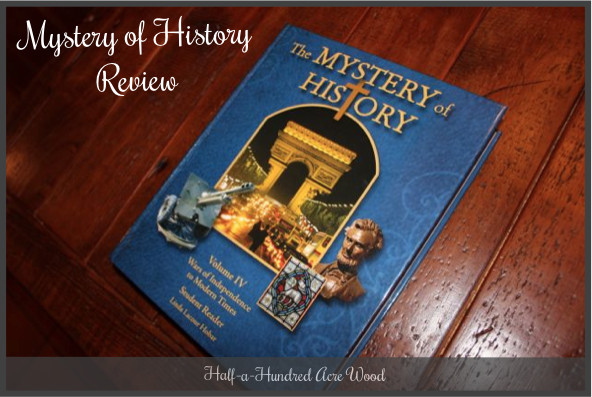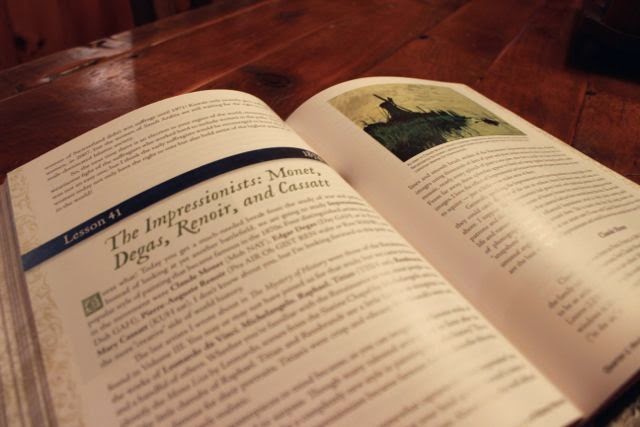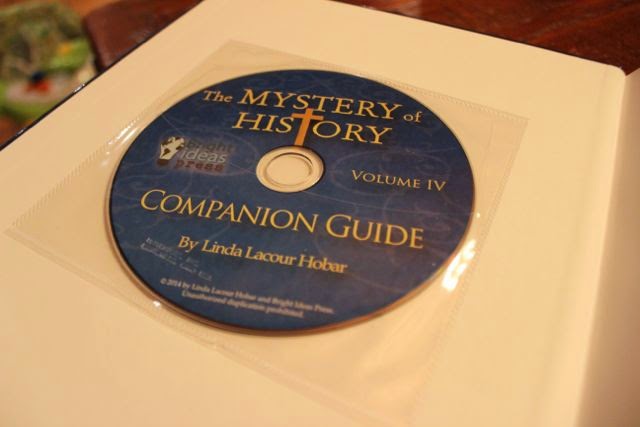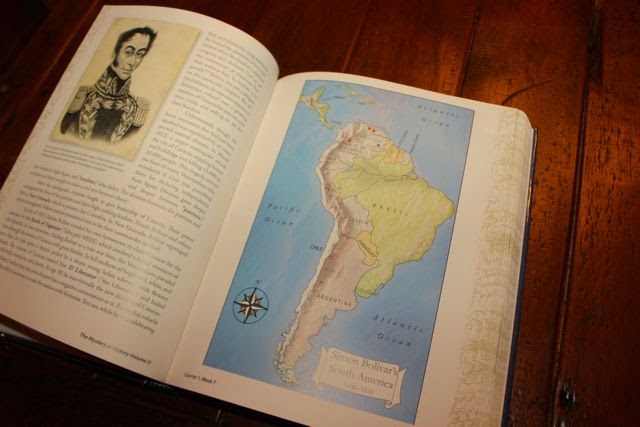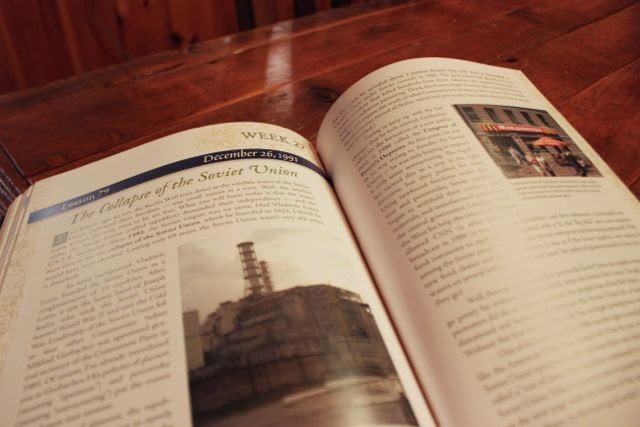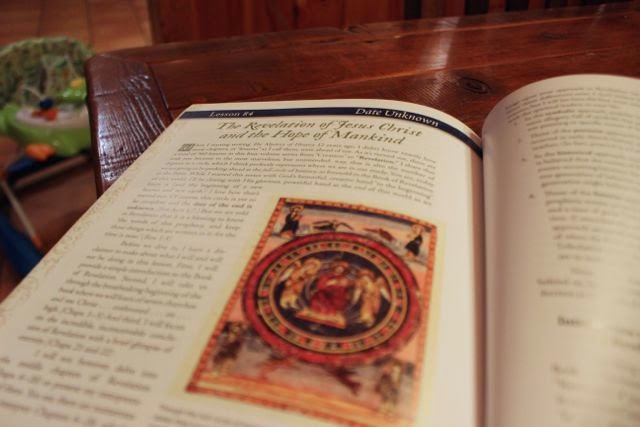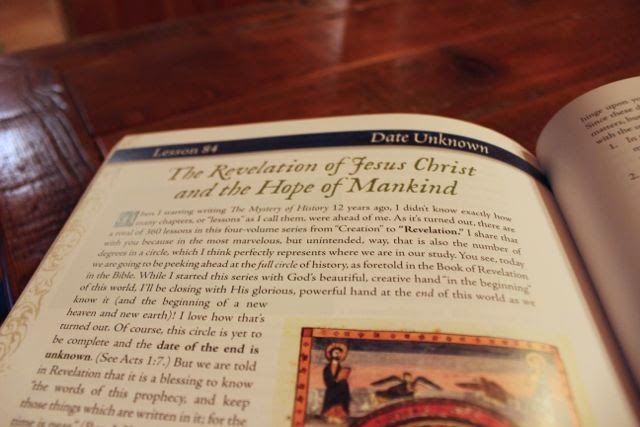It’s chronological. It’s Christian. And now it’s complete!
For those who have been searching for a comprehensive, Christ-centered history curriculum, the fourth and final volume of The Mystery of History (MOH) has arrived, so let’s give you a glimpse of what’s in store!
As we wrap up our reading of the four volumes of Story of the World this month, I find myself once again reconsidering our history choices in preparation for next year. For the past four years, we’ve used Story of the World audios alongside our memory work, and we certainly can repeat the readings from those four volumes now that we are finished. After all, repetition is at the heart of classical education! Nevertheless, I have anticipated The Mystery of History’s completion for the past three or four years, and it seems fitting that we would look further into The Mystery of History now that we’ve finished our first journey through the pages of all four volumes of Story of the World.
The Mystery of History
Although we enjoyed reading through the first volume of The Mystery of History about three years ago, I had not purchased any of the other volumes because the The Mystery of History series was (at that time) incomplete. That same year we had also enjoyed listening to the first two volumes of The Story of the World. While The Story of the World provided engaging narratives (i.e., “living history”) from ancient times, The Mystery of History provided us with deeper Biblical connections that I had failed to notice as I continue to overcome my segmented and compartmentalized understanding of history. That year, it was a wonderful thing to dovetail Story of the World with The Mystery of History, which is why I’m considering it once again. Simply put, The Mystery of History tends to fill a gap that exists in our homeschool due to my own lack of knowledge and understanding. Now that the final volume of The Mystery of History is published, I’m glad to have another option to consider for a complete, chronological, and classical history study – one that presents history from a Biblical worldview.
Written by homeschooling mom Linda Hobar, the four volumes of The Mystery of History include:
- Volume 1 Creation to the Resurrection (c. 4004 BC – c AD 33)
- Volume II The Early Church and the Middle Ages (c. AD 33 – 1456)
- Volume III The Renaissance, Reformation, and Growth of Nations (C 1455-1707)
- Volume IV Wars of Independence to Modern Times (1708 – 2014)
This review is specifically for Volume IV Wars of Independence to Modern Times, an illustrated hardbound student reading text…
…which also includes a CD-ROM that includes a 600+ page Companion Guide with pretests, multi-age activities, quizzes, mapping exercises, timeline directions, and more.
Recommended for grades 6 and above due to reading level and emotional intensity (as also mentioned by Susan Wise Bauer for Story of the World Volume 4 re: the nature of the events from this time period), The Mystery of History Volume IV covers the wars of independence to modern times, including Wars of Independence, Wars of Ideologies, Wars of the World, Wars of Modern Times, and the Hope of Mankind. Other historical figures highlighted include Napoleon, Beethoven, Simon Bolivar, George Muller, Harriet Tubman, Martin Luther King Jr., Billy Graham, Nelson Mandela, and other notable persons ranging from artists and composers to revolutionaries and missionaries. As the author weaves Biblical history into secular world history, she provides an integrated view of the one story of mankind and the message of the Gospel through the ages.
Volume IV provides everything needed to teach this period of history from a Christian perspective, along with multi-age activities, book and video recommendations, timeline suggestions, map work, and assessments. It is composed of 84 lessons to be completed in a 28-week period, with each week containing three reading lessons. This allows for an extra day or two each week to complete extra activities or suggested field trips.
The Mystery of History Pros
The breadth of history covered. Even the lives of composers and artists are woven into the story. This reminds me of a certain goal of a Classical, Christian education: all subjects relate to one another, and they all point back to our Creator.

Transitions and connections. When the author covers a subject connected to something previously mentioned, she gives a brief synopsis to remind us of it instead of jolting us from one event to the next without a transition. It builds in some repetition (without seeming repetitious), which also helps with retention.
Classical in its approach. History is not just read and subsequently forgotten. Each week a reminder is provided for the student to create “Challenge Cards” which are used for oral drills, games, or independent review.
Companion Guide includes a variety of ideas with instructions for multi-age, multi-sensory activities. This could be seen as a plus or a minus. It provides flexibility to do as much or as little as you’d like. Dig in way-deep or just read the lesson – it’s your choice! There’s no doubt the number of activities and suggestions can make the text adaptable to a much wider age span.
Companion Guide is on CD instead of within text. This could also be seen as a plus or a minus. Personally, I tend to like things pre-printed. But having the extra activities on the Companion Guide allows for the making of multiple copies easily when needed, and it keeps this volume at a size that is not overwhelming. So… what is included in the Companion Guide? The Companion Guide contains…
- Quarter Summaries
- Pretests
- Instructions for making timelines, memory cards, and a history notebook
- Map work
- Quarterly worksheets
- Quizzes and semester tests
- Answer keys
- Supplemental reading/video list
- Extra activities and instructions for using The Mystery of History for high school students to gain a high school history credit
Treats non-Christian topics respectfully while sharing the truth and hope of the Gospel. The author touches on the Christian faith in a beautiful, non-condemning way and references the scriptures where appropriate (e.g., How Marxist principles go against God’s Word). In some cases, the author suggests that younger students stop reading at a certain point due to sensitive content, in which case a note to the teacher is usually included so that you won’t be caught off guard. Although it is recommended for grades 6 and above, this volume can be read to children, though parents may want to skip some of the more intense subjects.
The Mystery of History Cons
Although mostly engaging, it is generally only engaging for specific areas of history. (This applies to almost all history texts.) Some of the topics are not written in as interesting or engaging a manner as others. Although the author does insert quotes into the historical summaries, most of it is not written in a story format, which makes it more difficult to engage the interest of young children.
Colloquial phraseology. This is such a petty complaint, but all the “in-case-you-didn’t-know” and “in-my-opinion” phrases seem distracting to me. The writing would be so much better without so many of those colloquial phrases inserted into it.
Not sufficient for American History study. Even though a great deal of American history is covered within this volume, it is not a comprehensive study of American history for those who wish to study U.S. history in depth.
Questionable content caught me off-guard. Although we enjoyed Volume 1 and the majority of Volume 2 of The Mystery of History, there exists some questionable content that caused us to stop listening to the audios during Volume 3. That content includes (starting in Volume 3):
- The sexual preference of certain persons (presented as sin but not something I want to bring up while listening to audios)
- Love life drama of various persons (including speculation about things like contracting a disease through a promiscuous lifestyle)…
- …which is why my husband and I thought it was falling too much into gossip. (This was especially difficult to manage while listening to audios.) Some of the things shared in the narrative are not necessary to the story.
If you are reading it aloud, you can adjust the readings, but because we were listening to it in the car, we didn’t have that option. The Mystery of History is a very good program, but not one I recommend listening to audios with children up to age 12.
Story of the World vs. The Mystery of History: A Short Comparison
Although it would take me several more months of reading to complete (or even start) a thorough comparison of the content of these two programs, I’d like to offer a short comparison for those who are trying to make a decision between the two.
- Both are a four-year, classical, chronological studies of world history.
- The first volume of both Story of the World and The Mystery of History were simple and engaging enough for our boys (at the time aged 4, 6, and 9) to understand. Overall, The Mystery of History seems to be written at a higher level than the earlier volumes of Story of the World.
- To expand upon the previous point: The format of Story of the World is geared towards a younger audience. Susan Wise Bauer uses the stories from world cultures told from a child’s point of view to show what life was like in ancient civilizations. The Mystery of History is not written in this historical-fiction story-like format, but many times it goes into greater depth/breadth.
- While Story of the World is a world history book with Biblical history incorporated into the text, The Mystery of History is a Biblical history book with world history interwoven throughout. As such, The Mystery of History gives a greater and deeper connection to the Christian faith and includes scripture references throughout the volumes.
- When listening to or reading Volume 1 and 2 of Story of the World, I often felt the need to stop and explain the text, such as the difference between myths and legends and actual historical accounts, since the presentation of Biblical people & events seems to be presented in the same way as Greek myths and ancient legends. Parts about the Islamic pillars of faith were also somewhat confusing for our children. While we enjoyed the narrative style of Story of the World, I honestly wrestled with these things and would have preferred a Christ-centered history curriculum (even though it was somewhat beneficial to wrestle through those things together).
- The Story of the World can be completed in a shorter period of time than The Mystery of History. It’s feasible to read through the four volumes of The Story of the World in two years (which is how we prefer to read our history, as it matches up more easily with the three cycles of the Classical Conversations Foundations program). However, it would be fairly intense to complete four volumes of The Mystery of History in two years.
- Due to the questionable content, our family actually prefers The Story of the World over The Mystery of History. (It’s easier to incorporate the audiobooks on roadtrips!)
As I consider which of these programs I would recommend, I can’t help but recommend both for different reasons. Beginning with Story of the World better engages a young child in the story of mankind due to its story-like qualities, but reading The Mystery of History helps to bridge the gap in understanding how history relates to scripture.
Are you curious to see more? Click here to download the TOC for The Mystery of History Volume IV.
Other related posts:
I was given a copy of The Mystery of History Volume IV for the purpose of reviewing it. The opinions expressed here are my own and have not been influenced by any outside source.

